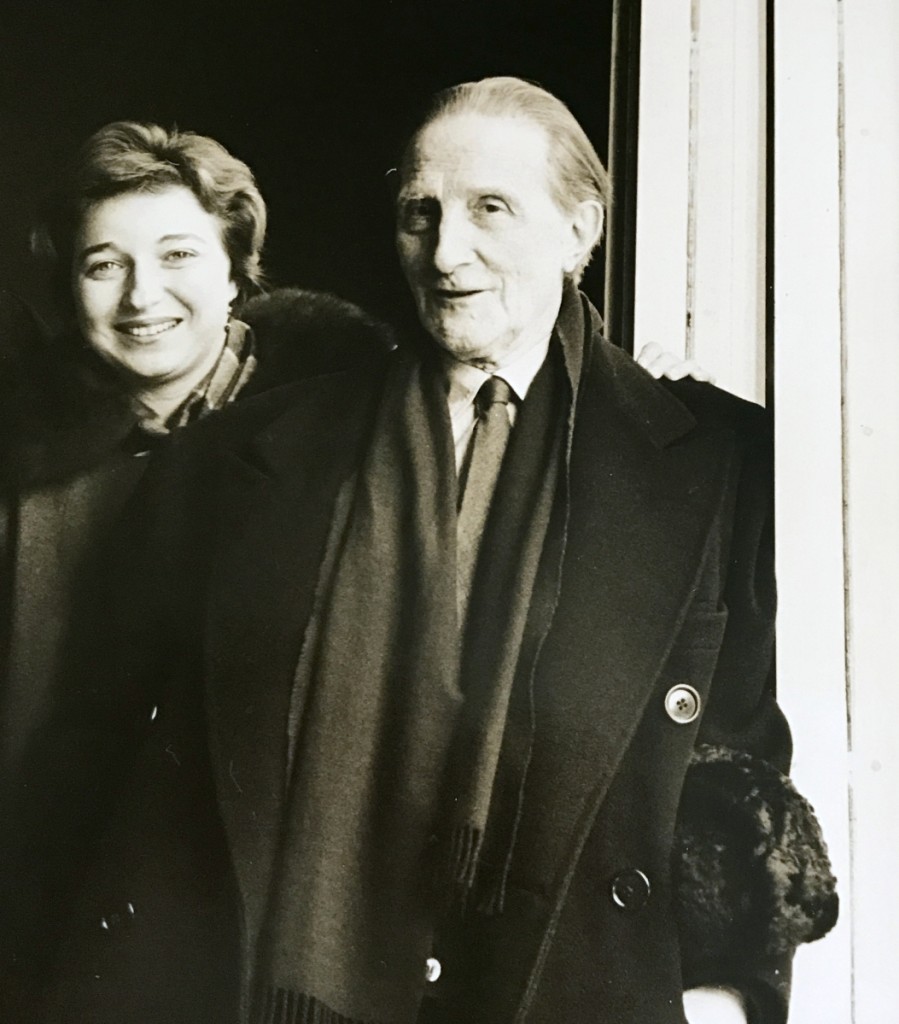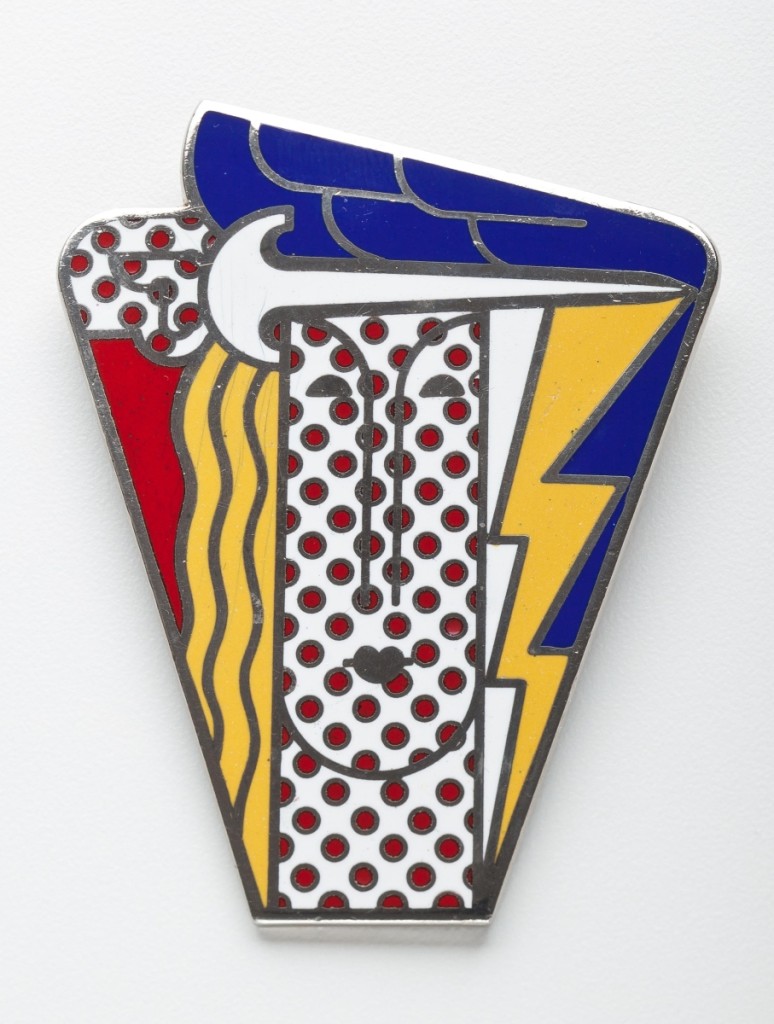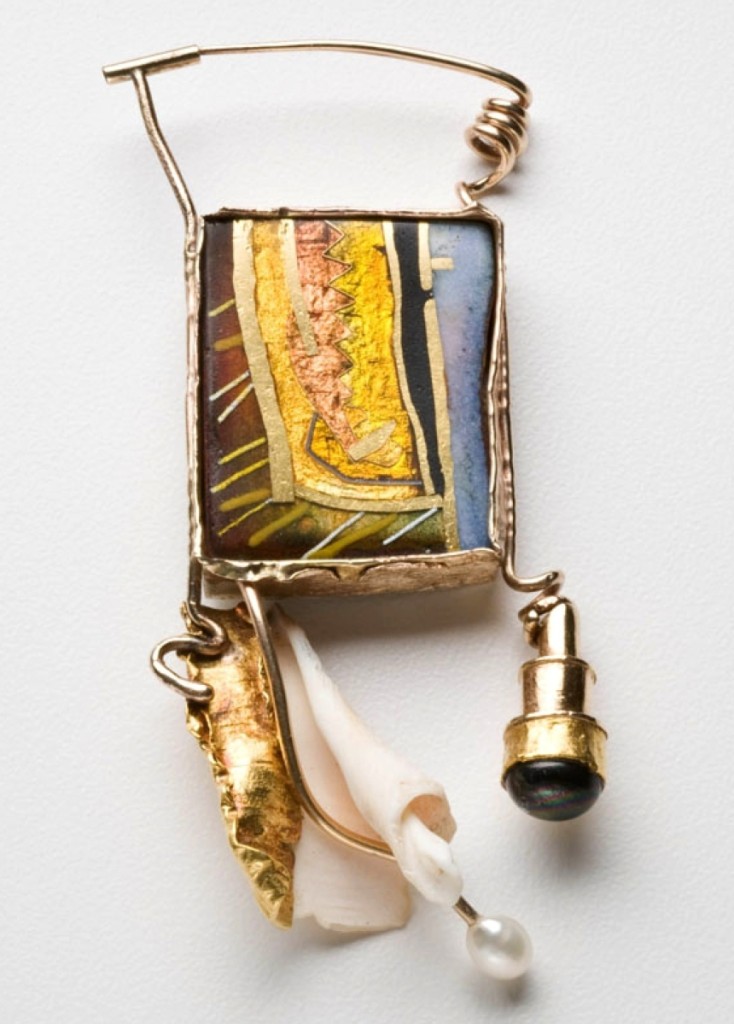
Leah Gordon is all smiles here with Marcel Duchamp in this photograph taken during her career as an arts writer for Time.
Leah Gordon has been a dealer for more than three decades, specializing in vintage and artist jewelry. A native of Sharon, Penn., Gordon opened Leah Gordon Antiques in New York in 1988 after working for 28 years at Time magazine as an art reporter. It was during those years that she gathered her love and deep knowledge of art, interviewing and writing about the famous artists of the Twentieth Century including Alexander Calder, Marcel Duchamp, Willem de Kooning, Andy Warhol and many others. “It was a job,” she said, “But what a job.”
Tell us about your background and how did you get started as a jewelry dealer? Why?
I had been an art reporter for Time magazine for 28 years and retired in 1988 when I opened Leah Gordon Antiques. I had a strong art background and the artists who were making artist jewelry were not new to me. I went back to school after I left Time and studied appraising in the decorative arts with an emphasis on jewelry design at New York University. I also took classes at the Gemological Institute of America. For the first ten years, I was a show dealer, traveling to shows around the country from Santa Fe to Florida to Wilton, Conn. In 1999, I opened a shop at the Manhattan Arts & Antiques Center in New York City.
What was it like to work for Time magazine?
Working for Time from 1960 to 1988 was like living in a whirlwind. It was an exciting news period and the art world was bursting with new artists, new ideas and new styles.
Most interesting assignment?
The artist interview that stands out as memorable was the one I did with Joseph Cornell, who rarely gave interviews. I spent a day with him at his home. Needless to say, Jacques Lipschitz, whom I interviewed several times, was a delight. And Salvador Dali, who stood me up, and then called to apologize and invited me to come have tea with him and his wife Gala at the St Regis, was someone I will always remember.
Tell us about your specializing in artist jewelry.

This boldly designed champlevé enamel brooch by Pop artist Roy Lichtenstein was originally produced in 1968 for the Multiples gallery in New York City. It is a pendant and brooch with a pin on the back and a ring for suspension from a chain. The enamel is on a base metal.
I was always interested in artist jewelry generally made by artists who are painters and sculptors who happen to make jewelry. Artists like Calder, who is best known for his mobiles, and Pablo Picasso … but they happen to make jewelry: pieces for friends, wives, girlfriends or boyfriends – sometimes just as whimsy. A lot of people didn’t know about this. I carried a full range of jewelry, like studio jewelry by Art Smith, too, but I was much more interested in artists. A lot of these men made multiples. To make one example of jewelry in gold, that’s very costly and they often didn’t do the goldsmithing themselves, they had someone else. And very often they worked in multiples. Goldsmithing was a high, high craft in itself, and most used goldsmiths, with the exception of Alexander Calder who did his own. Wassily Kandinsky also did jewelry. It’s interesting how many artists did.
What was the first piece of jewelry you bought?
I bought Picasso early; I remember being interested in Picasso when hardly anyone was paying attention to his jewelry in the early 2000s. I was also buying Georges Braque and Roy Lichtenstein. I’m trying to think what’s in my personal jewelry box. I have always favored the French jewelers. I always loved buying Picasso’s jewelry because it was exciting. Braque made wonderful jewelry at the end of his life, the last two years from 1961 to 63. He didn’t produce that much, so his pieces are not well known.
Best or most interesting piece you’ve ever sold?
I’ve sold a lot. I’ve sold pieces by William Harper, a contemporary sculptor who lives in Manhattan. He’s been around for a long time and he’s a sculptor, but his strong suit is as an enamelist. He makes beautiful enamels, mostly brooches and pendants, occasionally earrings, not often though. His pieces are quite individual. I can remember the first time I walked into an art opening and I saw a woman wearing a brooch by him. I remember asking her, “Where did you get that?” and “Who…”

A gold and enamel brooch by William Harper, an American artist known for his jewelry in abstract and organic forms. This piece is made in gold and is highlighted by its enamel design with shell and pearl accents.
Is there a favorite piece in your collection that you won’t ever sell?
I’m not sure there is a personal piece I would never sell. I’m not philistine enough… Actually the personal pieces I have collected heavily have been Mexican silver, Taxco silver and pieces by Antonio Pineda. I wear a lot of Tiffany. I don’t think I would sell my Tiffany. I have had my Taxco silver for years and I am not inclined to sell.
Do you wear artist jewelry everyday?
Like so many women, when I go into my jewelry box to pick out something to wear, I often pick out a pair of Tiffany earrings and Tiffany necklace. Artist jewelry is very special, so if you’re going to wear it, you usually wear it for a special occasion. It’s very special and when you wear it to an event like an antiques show or an art opening, even if you are an exhibitor or patron, you stand out with a piece of artist jewelry over and above the crowd as opposed to commercial jewelry. Now there’s nothing wrong with a piece of commercial jewelry, but when you put on a piece of artist jewelry, people always say, “Wow, what’s that?” and “Who did that?”
Tell us about Kandinsky’s work with jewelry.
Around 1903-04, Kandinsky did drawings for jewelry and he put them aside and never did anything with them. In the 1950s-60s these drawings were found among his effects and his wife took the drawings to a goldsmith in Munich named Max Pollinger. Pollinger fabricated the pieces with gold and they are multiples so there are 5/10 or 5/20, limited edition series. I had one on my website, a big one with a gold griffin with diamonds. It’s a stunner.
How are you running your business these days?
I closed my shop April 1 after my lease ran out. I’m not young and I wanted to take it a bit easier so I’m selling privately now and through my website.
-Andrea Valluzzo




